Anthony Casso
Anthony Salvatore Casso (May 21, 1942 – December 15, 2020), nicknamed "Gaspipe", was an American mobster and former underboss of the Lucchese crime family. During his career in organized crime, Casso was regarded as a "homicidal maniac"[1] in the Italian-American Mafia. He is suspected of having committed dozens of murders, and had confessed to involvement in between 15 and 36 murders.[2][3] Former Lucchese captain and government witness Anthony Accetturo once said of Casso, "all he wanted to do is kill, kill, get what you can, even if you didn't earn it."[4] In interviews, and on the witness stand, Casso confessed involvement in the murders of Frank DeCicco, Roy DeMeo, and Vladimir Reznikov. Casso also admitted to several attempts to murder Gambino family boss John Gotti.
Anthony Casso | |
|---|---|
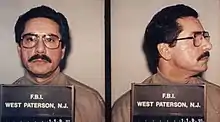 1993 FBI mugshot of Casso | |
| Born | Anthony Salvatore Casso May 21, 1942 New York City, U.S. |
| Died | December 15, 2020 (aged 78) Tucson, Arizona, U.S. |
| Other names | Gaspipe |
| Occupation | Mobster |
| Spouse(s) | Lillian Delduca
(m. 1968; died 2005) |
| Children | 2 |
| Allegiance | Lucchese crime family |
| Conviction(s) | Racketeering, extortion, murder (1998) |
| Criminal penalty | 455 years imprisonment |
Following his arrest in 1993, Casso became one of the highest-ranking members of the Mafia to turn informant. After taking a plea agreement, he was placed in the witness protection program, however, in 1998, it was rescinded and Casso was dropped from the program after several infractions. Later that year, a federal judge sentenced him to 455 years in prison for racketeering, extortion, and murder. Casso died in prison custody on December 15, 2020, from complications related to COVID-19.
Early life
Casso was born on May 21, 1942, in South Brooklyn, in New York City, the youngest of the three children to Michael and Margaret Casso (née Cucceullo). Casso's grandparents had immigrated to the United States from Campania, Italy in the 1890s. His godfather was Salvatore Callinbrano, a made man and caporegime in the Genovese crime family, which maintained a powerful influence on the Brooklyn docks. Casso dropped out of school at 16 and got a job with his father as a longshoreman. In his youth, he became a crack shot, firing pistols at targets on a rooftop which he and his friends used as a shooting range. Casso also made money shooting predatory hawks for pigeon keepers.[5]
Casso married fellow South Brooklyn native Lillian Delduca on May 4, 1968.[6] They had a daughter and son.
During his marriage, Casso had many infidelities. In an interview with Carlo, Casso recalled,
Most all men in my life, everyone I know, had girlfriends. It goes with the territory. Women are drawn to us, the power, the money, and we're drawn to them. But only in passing. Some guys treated their mistresses better than their wife, but that's a fuckin' outrage. No class. Only a cafone does that. I never loved any woman but Lillian. She and my family always came first.[7]
Lucchese crime family
Early criminal career
Casso was a violent youth, and member of the infamous 1950s gang, the South Brooklyn Boys.[8] In 1958, he was arrested after a "rumble" against Irish-American gangsters. Casso later told biographer Philip Carlo that his father visited him at the police station and tried in vain to scare his son straight. He soon caught the eye of Christopher "Christie Tick" Furnari, the capo of the "19th Hole Crew" in the Lucchese family. Casso started his career in the Mafia as a loanshark. As a protégé of Furnari, he was also involved in gambling and drug dealing. He was arrested for attempted murder in 1961, but was acquitted when the alleged victim refused to identify him.
During the 1970s, Casso was one of a string of Mafia associates who were suspected of turning informant for the US government.
19th Hole Crew
In 1974, at age 32, he became a made man, or full member, of the Lucchese family. Casso was assigned to Vincent "Vinnie Beans" Foceri's crew that operated from 116th Street in Manhattan and from Fourteenth Avenue in Brooklyn.[9][10] Shortly after becoming made, Casso became close to another rising star in the family, Victor Amuso, and began a partnership that would last for two decades. They committed scores of crimes, including drug trafficking, burglary and the murders of informants.
Casso later began reporting to Christopher "Christie Tick" Furnari, the caporegime of "the 19th Hole Crew".
Within Furnari's "the 19th Hole Crew" both Casso and Amuso joined a of burglary ring known as "the Bypass Gang", which included expert locksmiths, safe crackers, and experts in security alarm systems.[11] The members of the Bypass gang are suspected of committing burglaries in banks and jewelry stores throughout New York and Long Island.[11] Authorities estimated the Bypass gang stole more than $100 million from safety deposit boxes and vaults during the 1970s and 1980s.[11]
When Furnari became the Lucchese consigliere, he asked Casso to take over the 19th Hole Crew.[11] However, Casso declined, suggesting that Amuso be promoted instead. Casso opted to become Furnari's aide.[11]
In December 1985, Casso was approached by Gambino family capo Frank DeCicco regarding a planned coup in his own family.[12] John Gotti, another Gambino capo whose crew had been implicated in drug deals, was planning to kill his boss, Paul Castellano, and take over the Gambinos, and was looking for support among the acting bosses-in-waiting of the crime families affected by the Mafia Commission Trial.[13] According to Sammy Gravano, another of Gotti's co-conspirators who would later turn state's evidence, Casso offered the conspirators his support.[14] Casso himself would claim he tried to talk DeCicco out of participating in the coup, warning him that without official sanction from the Commission, all the participants would be murdered in revenge.[12] The hit went ahead regardless on December 16;[13] Casso would later denounce Gotti's actions to Carlo as "the beginning of the end of our thing."[12]
As Casso had warned, Lucchese boss Anthony Corallo and Genovese boss Vincent Gigante decided to kill Gotti and DeCicco, his new underboss, in revenge. Amuso and Casso were chosen to handle the assassinations, and were instructed to use a bomb to try and shift suspicion to Sicilian mobsters or Zips based in the US. While American mafiosi have long been (officially) banned from using bombs due to the risk of collateral damage, Sicilian mafiosi were notorious for blowing up their targets. Amuso and Casso made one attempt on the lives of Gotti and DeCicco, planting a bomb in DeCicco's car when the two were scheduled to visit a social club on April 13, 1986. Gotti cancelled at the last minute, however, and the bomb instead only killed DeCicco and injured a passenger they had mistaken for Gotti.[14]
Taking over the family with Amuso


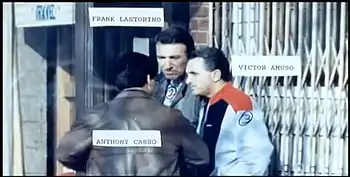
In the November 1986, Lucchese family boss Anthony Corallo sensed that the Commission Trial would result in a guilty verdict that would ensure the entire Lucchese leadership would die in prison.[15] Corallo wanting to maintain the family's half-century tradition of a seamless transfer of power called both Casso and Amuso to Furnari's Staten Island home.[15] Casso turned down the promotion to boss and instead suggested that Amuso become the new boss.[15] Amuso formally took over the family in 1987 and Casso succeeded Furnari as consigliere.[15] Casso later took over as Underboss in 1989 after Mariano Macaluso retired.
While at the top of the Lucchese family, Amuso and Casso shared huge profits from their family's illegal activities. These profits included: $15,000 to $20,000 a month from extorting Long Island carting companies; $75,000 a month in kickbacks from eight air freight carriers that guaranteed them labor peace and no union benefits for their workers; $20,000 a week in profits from illegal video game machines; and $245,000 annually from a major concrete supplier.[16] Amuso and Casso also split more than $200,000 per year from the Garment District rackets, as well as a cut of all the crimes committed by the family's soldiers.
In one instance, Casso and Amuso split $800,000 from the Colombo family for Casso's aid in helping them rob steel from a construction site at the West Side Highway in Manhattan. In another instance, the two bosses received $600,000 from the Gambino family for allowing them to take over a Lucchese-protected contractor for a housing complex project on Coney Island. Casso also controlled Greek-American gangster George Kalikatas, who gave Casso $683,000 in 1990 to operate a loan sharking and gambling operation in Astoria, Queens.
Eastern European connections
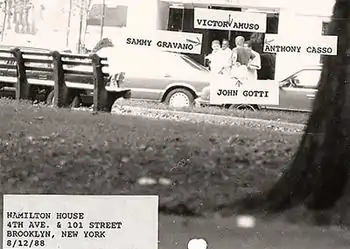
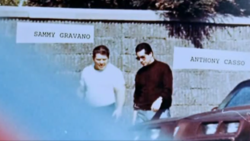
Casso had a close alliance with Russian boss Marat Balagula, who operated a multibillion-dollar gasoline bootlegging scam in Brighton Beach. Balagula, a Soviet Jewish refugee from Odessa, had arrived in the US under the Jackson-Vanik Amendment. After Colombo capo Michael Franzese began shaking down his crew, Balagula approached Christopher Furnari, consigliere for the Lucchese crime family, and asked for a sit-down at the 19th Hole Crew's social club in Brooklyn. According to Casso, Furnari declared,
Here there's enough for everybody to be happy...to leave the table satisfied. What we must avoid is trouble between us and the other families. I propose to make a deal with the others so there's no bad blood...Meanwhile, we will send word out that from now on you and your people are with the Lucchese family. No one will bother you. If anyone does bother you, come to us and Anthony will take care of it.[17]
Street tax from Balagula's organization was not only strategically shared, but also became the Five Families' biggest moneymaker after drug trafficking. According to Carlo,
It didn't take long for word on the street to reach the Russian underworld: Marat Balagula was paying off the Italians; Balagula was a punk; Balagula had no balls. Balagula's days were numbered. This, of course, was the beginning of serious trouble. Balagula did in fact have balls—he was a ruthless killer when necessary—but he also was a smart diplomatic administrator and he knew that the combined, concerted force of the Italian crime families would quickly wipe the newly arrived Russian competition off the proverbial map.[18]
Shortly afterward, Balagula's rival, a fellow Russian immigrant named Vladimir Reznikov, drove up to the former's office building in the Midwood section of Brooklyn. Sitting in his car, Reznikov opened fire on the building with an AK-47. One of Balagula's close associates was killed and several secretaries were wounded.[18] Then, on June 12, 1986, Reznikov entered the Rasputin nightclub in Brighton Beach and placed a 9mm Beretta against Balagula's head, demanding $600,000 in exchange for not pulling the trigger. He also demanded a percentage of everything Balagula was involved in. After Balagula promised to get the money, Reznikov threatened him and his family.[19]
Shortly after Reznikov left, Balagula suffered a massive heart attack. He insisted on being treated at his home in Brighton Beach, where he felt it would be harder for Reznikov to kill him. When Casso arrived, he listened to Balagula's story and seethed with fury. Casso later told Carlo that, to his mind, Reznikov had just spat in the face of the entire Cosa Nostra. Casso and Amuso got Funari's permission to have Reznikov killed.[20] Casso told Balagula, "Send word to Vladimir that you have his money, that he should come to the club tomorrow. We'll take care of the rest."[21] Balagula responded, "You're sure? This is an animal. It was him that used a machine gun in the office."[19] Casso responded, "Don't concern yourself. I promise we'll take care of him...Okay?" Casso then requested a photograph of Reznikov and a description of his car.[21]
The following day, Reznikov returned to the nightclub to pick up his money. Upon realizing that Balagula wasn't there, Reznikov launched into a barrage of profanity and stormed back to the parking lot. There, he was shot dead by DeMeo crew veteran Joseph Testa, who jumped into a car driven by Anthony Senter and left Brighton Beach. According to Casso, "After that, Marat didn't have any problems with other Russians."[22]
Fugitive
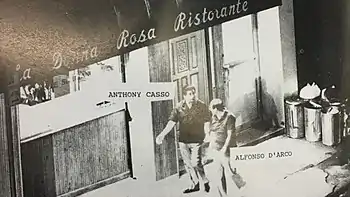


On July 29, 1991, due to a tipoff from an unidentified Lucchese insider, Amuso was arrested and Casso was secured the de facto boss of the family.[23][24] It has been speculated that Casso himself was the source for the leak, as only a few people were privy to Amuso's location.[25] This theory is contradicted, however, by Carlo, who states that Casso had no desire to be boss of the Lucchese family and attempted to arrange for Amuso's escape from federal custody after his arrest. To the disappointment of Casso and the Lucchese capos, Amuso refused to leave prison out of fear for his life. As a result, the Lucchese capos asked Casso to take over as acting boss. Casso reluctantly accepted.
In early 1991, Amuso and Casso ordered the murder of capo Peter Chiodo, a fellow Windows Case defendant who had pleaded guilty without the family's approval. Chiodo barely survived an assassination attempt and subsequently agreed to turn state's evidence.[26] In September that year, acting boss Alphonse "Little Al" D'Arco, convinced Casso had marked him for death following his failure to kill Chiodo, also surrendered and agreed to testify. Both of these defections opened the door for new murder indictments against Amuso and Casso.[24] In another incident in 1993, Casso used Brooklyn faction-leaders George Zappola and Frank "Bones" Papagni, as well as Lucchese consigliere Frank "Big Frank" Lastorino, to kill former underboss and Bronx faction leader Stephen "Wonderboy" Crea. However, due to the massive indictments at the time, all members of the plot, including Casso, were eventually incarcerated on various charges. Casso was arrested at a mistress's home in Mount Olive, New Jersey, on January 19, 1993.[27]
Informant
Casso was held at New York's Metropolitan Correctional Center pending trial. Facing charges that would have all but assured he would die in prison, he began making escape plans.[28] One plan almost succeeded when a bribed guard cleared him through security; Casso nearly walked out of jail, but was spotted by another guard and thwarted at the last minute.[29] Afterwards, Casso began making plans for Lucchese members to find out what prison buses would be transporting him and arrange an ambush,[30] as well as assassinating the presiding judge, Eugene Nickerson, to buy himself more time.[29]
However, all of this came undone when Amuso not only stripped Casso of his title of underboss, but declared that all Lucchese mafiosi should consider him a pariah—in effect, banishing Casso from the family.[31] Amuso had long been suspicious of Casso's failure to use his law enforcement contacts to find out who betrayed him,[32] and finally concluded Casso did it himself to take control of the family.[29] Facing the prospect of a trial at which D'Arco, Acceturo, and Chiodo were due to be star witnesses against him, as well as spending the rest of his life in prison, Casso offered to turn informant himself just before his trial was due to begin. He finalized a plea agreement at a hearing on March 1, 1994, where he pleaded guilty to 70 crimes spelling out a litany of Mafia-related crimes, including racketeering, extortion and 15 murders.[2] The two lead prosecutors on the case, Charles Rose and Gregory O'Connell, later said they'd feared Casso could be acquitted at trial, since they did not have any taped conversations as evidence. However, with Casso's guilty plea, O'Connell said they had Casso "tied up six ways to Sunday."[29][3] Casso was placed in the witness protection program.
Casso disclosed that two retired NYPD detectives had been on the Lucchese payroll. These detectives were later determined to be Louis Eppolito and Stephen Caracappa, who committed eight of the eleven murders Casso had ordered. Carracappa and Eppolito had also given Casso information which led to many others as well, revealing the names of potential informants. They were subsequently found guilty on all charges and sentenced to life in prison. However, when Casso revealed that he also had an FBI agent on the payroll, prosecutors ordered him to keep quiet. Casso further enraged the US government by accusing Gambino turncoat Sammy Gravano of committing multiple felonies which he had later denied on the witness stand. Casso claimed to have sold large amounts of cocaine, heroin, and marijuana to Gravano over two decades. Once again, no one was interested. However, Casso was vindicated to some extent when Gravano pleaded guilty in 2000 to operating a massive narcotics ring, which included selling ecstasy to adolescents.[33] He was the second confessed underboss of a New York crime family to break his blood oath and turn informer, after Gambino underboss Gravano.
In 1998, Casso was removed from the witness protection program after prosecutors alleged numerous infractions, in 1997, including bribing guards, assaulting other inmates and making "false statements" about Gravano and D'Arco. Casso's attorney tried to get Judge Frederic Block to overrule federal prosecutors in July 1998, but Block refused to do so.[34][35] Shortly afterward, Judge Block sentenced Casso to 455 years in prison without possibility of parole—the maximum sentence permitted under sentencing guidelines.[36][35] Casso later told The New York Times' organized-crime reporter Selwyn Raab that, before turning informer, he was seriously considering a deal that would have allowed him the possibility of parole after 22 years. "I help them and I get life without parole," he said. "This is really a fuckin' joke."[37] Casso lost two subsequent appeals to get his sentence reduced.[35]
In a 2006 letter to Carlo, Casso declared,
I am truly regretful for my decision to cooperate with the Government. It was against all my beliefs and upbringing. I know for certain, had my father been alive, I would never have done so. I have disgraced my family heritage, lost the respect of my children and close friends, and most probably added to the sudden death of my wife and confidant for more than 35 years. I wish the clock could be turned back only to bring her back. I have never in my life informed on anyone. I have always hated rats and as strange as it may sound I still do. I surely hate myself, day after day. It would have definitely been different if the Government had honest witnesses from inception. I would have had a second chance to start a new life, and my wife Lillian would still be alive. It seems that the only people the Government awards freedom to are the ones who give prejudiced testimony to win convictions. "The truth will set you free," means nothing in the Federal courts. Even at this point in my life, I consider myself to be a better man than most of the people on the streets these days.[38]
Incarceration and death
Casso began serving his sentence at the supermax prison ADX Florence in Florence, Colorado. According to the Federal Bureau of Prisons, Casso was transferred to the Federal Medical Center (FMC) at the Federal Correctional Complex in Butner, North Carolina, for the treatment of prostate cancer in March 2009.[39] He was returned to ADX Florence in July 2009. By 2013, Casso had been transferred to the Federal Residential Reentry Management Office in Minneapolis, Minnesota.[40] This is not a prison facility, but rather an administrative designation for inmates assigned to home confinement, "halfway houses", or state and county correctional facilities. As of May 2018, he had been transferred to the United States Medical Center for Federal Prisoners, an administrative security/medical prison in Springfield, Missouri.[40] He was later transferred to USP Terre Haute. From March 25, 2020, he was serving his sentence at USP Tucson, a high security prison in Arizona.[40][41]
On November 5, 2020, Casso tested positive for COVID-19, amid its pandemic in the United States, while incarcerated; he was placed in medical isolation USP Tucson.[41][42] On November 9, he was transported to a local hospital due to respiratory distress, and on November 17, 2020, was placed on a ventilator.[41] His lawyers requested compassionate release, but that motion was rejected on November 28.[43] On December 15, 2020, Casso died from complications related to prostate cancer, coronary artery disease, kidney disease, hypertension, bladder disease and lung issues from years of smoking, and COVID-19, at the age of 78.[41][43]
References
- Ackman, Dan (March 17, 2006). "Dispatches From a Mob Trial". Dispatches. Slate. Retrieved September 27, 2011.
- leagle.com (June 29, 1998). "U.S. v. Casso". Leagle.com. Retrieved November 16, 2012.
- Peterson, Helen (July 1, 1998). "Wiseguy Won't Get Fed Aid On Sentence". New York Daily News. Retrieved August 7, 2011.
- Raab 2005, pp. 507–09.
- Capeci, Jerry (June 12, 1997). "Mob Turncoat's Sentence Reduced". New York Daily News – via www.nydailynews.com.
- Carlo 2008, p. 46.
- Carlo 2008, pp. 185–86.
- Raab 2005, p. 147.
- Carlo 2008, pp. 85–86.
- National Council on Crime and Delinquency – 1969 Volume 44. (Page 147) see Vincent Foceri
- Raab, Selwyn (October 4, 2016). Five Families The Rise, Decline, and Resurgence of America's Most Powerful Mafia Empires. St. Martin's Publishing Group. p. 472. ISBN 9781250101709. Retrieved December 20, 2020.
- Carlo 2008, pp. 134–36.
- Raab 2005, pp. 371–75.
- Raab 2005, pp. 473–75.
- Raab, Selwyn (October 4, 2016). Five Families The Rise, Decline, and Resurgence of America's Most Powerful Mafia Empires. St. Martin's Publishing Group. p. 477. ISBN 9781250101709. Retrieved December 20, 2020.
- Raab 2005, p. ?.
- Carlo 2008, p. 120
- Carlo 2008, p. 152.
- Carlo 2008, p. 153.
- "Russian Organized Crime in the United States". p. 45
- Carlo 2008, p. 154.
- Friedman 2000, p. 55.
- McQuiston, John (July 30, 1991). "Fugitive In Mob Case Is Arrested". The New York Times. Retrieved August 26, 2012.
- Raab 2005, pp. 499–501.
- Volkman 1998, p. 281.
- Raab 2005, pp. 496–98.
- Raab 2005, p. 511.
- Lawson & Oldham 2007, p. 257.
- Raab 2005, pp. 512–14.
- Lawson & Oldham 2007, pp. 261–62.
- Raab 2005, pp. 512–514.
- Lawson & Oldham 2007, p. 264.
- Carlo 2008, p. ?.
- Raab, Selwyn (July 1, 1998). "Plea Deal Rescinded, Informer May Face Life". The New York Times – via nytimes.com.
- "Mafia Informer's 2nd Appeal Says His Plea Deal Was Undercut". nytimes.com. November 23, 2000.
- Raab 2005, p. 522.
- Raab 2005, p. 525.
- Carlo 2008, p. 337.
- Blumenthal, Ralph (February 21, 2009). "Mobster Makes Offer on French Connection Case". The New York Times. Retrieved November 23, 2012.
- "Inmate Locator". www.bop.gov.
- "Inmate Death at USP Tucson" (PDF). bop.gov. December 16, 2020.
- "Jailed mobster Anthony 'Gaspipe' Casso has COVID-19, judge rejects motion for release". nydailynews.com. November 30, 2020.
- "Mobster Anthony 'Gaspipe' Casso, who murdered dozens and caught COVID-19 behind bars, dead at 78". nydailynews.com. December 16, 2020.
Works cited
- Carlo, Philip (2008). Gaspipe: Confessions of a Mafia Boss. New York: HarperCollins. ISBN 978-0061429842.
- Friedman, Robert I. (2000). Red Mafiya: How the Russian Mob Has Invaded America. Boston; New York; London: Little, Brown and Company. ISBN 0316294748.
- Lawson, Guy; Oldham, William (2007). The Brotherhoods. Pocket Books. ISBN 978-1-4165-2338-3.
- Raab, Selwyn (2005). Five Families: The Rise, Decline and Resurgence of America's Most Powerful Mafia Empires (2006 ed.). New York: Thomas Dunne Books. ISBN 978-0312361815.
- Volkman, Ernest (1998). Gangbusters: The Destruction of America's Last Great Mafia Dynasty (1999 paperback ed.). New York: Avon Books. ISBN 0380732351.
Further reading
- Capeci, Jerry; Mustain, Gene (1996). Gotti: Rise and Fall. Penguin Books Canada, Limited.
- Kelly, Robert J. (2000). Encyclopedia of Organized Crime in the United States. Westport, Connecticut: Greenwood Press. ISBN 0-313-30653-2.
- Pistone, Joseph D.; Brandt, Charles (2007). Donnie Brasco: Unfinished Business. Running Press Book Publishers. ISBN 978-0-7624-2707-9.
External links
- Anthony Casso – Biography.com
- The Lucchese Family – TruTV Crime Library
- Federal Bureau of Prisons Inmate Locator: Anthony Casso (Life)
| Business positions | ||
|---|---|---|
| Preceded by Mariano "Mac" Macaluso |
Lucchese crime family Underboss 1989–1993 |
Succeeded by Steven Crea |